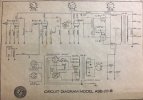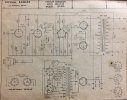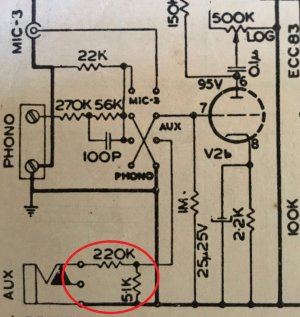Mohd asnain
New Member
Do you have it's circuit digram if yes please do let me knowOk sir
Do you have it's circuit digram if yes please do let me knowOk sir
Thank you so much. The Amps are here now, after needed restoration. I will study them and your suggestions. Thank k you so much. If I can achieve this, I will definitely report back.You shall need a mm phono pre amp.
The mic input is for dynamic microphones, it has a input sensitivity that is a few mv, it will beoverloaded by connecting a line level input there. If you check the third input that is selectable between mic, aux and cer. picshono, you shall find the register that connects when the switch is on aux. Wire in a register of the same value to the mic inputs to convert them for line level. In short, check the circuit for the aux input and replicate that for the mic input.
You must be aware, but just mentioning that you shall need two of these Amps for stereo.
Regards,
unfortunately no, but have the 20-B and 20-BAAny circuit for the ase18 ?


Working with the TM50 is an easy experience. Be careful with the 100v line speaker output on the rear. Wire your speaker to the appropriate speaker terminal. Connect your source to the Aux input as the gain of the phono input may be a bit high for a CD player. Use only dynamic microphones with the mic input. Connecting a cd player to the mic input will result in heavily distorted overloaded sound. However if you plug a electric guitar into the microphone socket and raise the volume control on the guitar, you'll get a nice distorted tone (but that's useful only if you are a guitar player of courseHello Friends,
A set of TM 50s, completely restored and matched are on their way! I expect to lay my hands on them tomorrow. Excited. This will be my first experience with Tube Amps. I have been only using SS amps. Can anyone share a User’s Manual of this or a similar Amp please? I am already terrified that I will blow these amps if I make a mistake. I have been reading several alerts and warnings / Dos and Don’s about Tube Amps, randomly. If someone can please share a list of basic DOs and DON’Ts, if not a User’s Manual, I will be grateful. Thanks in anticipation.
Vijay Dumbali
thanks @reubensm , i think only the output section varies between them 18B has 6V6 instead of EL84.unfortunately no, but have the 20-B and 20-BA
View attachment 67869
View attachment 67870
These circuits are from the book series titled - Popular Amplifier Circuits, by Gyan C Jain, Published by the Business Promotion Bureau, New Delhi
Volume 1 - 15th April 1973
Volume 3 - 1st June 1979
Circuit Courtesy: FM Greenhorn
Thank you so much for these inputs. These are very valuable for me. I am sure having issues of very high gain with phono input. I now know which one to use as Aux and which ones on the Phono. Thanks a lot @reubensmWorking with the TM50 is an easy experience. Be careful with the 100v line speaker output on the rear. Wire your speaker to the appropriate speaker terminal. Connect your source to the Aux input as the gain of the phono input may be a bit high for a CD player. Use only dynamic microphones with the mic input. Connecting a cd player to the mic input will result in heavily distorted overloaded sound. However if you plug a electric guitar into the microphone socket and raise the volume control on the guitar, you'll get a nice distorted tone (but that's useful only if you are a guitar player of course)
@reubensm Hello. Moved forward. Could set up my system as advised by you. The vocals are coming out too nice. Maybe because this TM50 is basically designed for PA! Quit good sound stage. But, I have this ‘angry insect’ high frequency hiss emanating from the tweeter. I have tried isolating all inputs to the Amp but to no avail. I tried swapping the pre-amp tubes. I did not try swapping power amp tubes, thought it may not help. The hiss remains. It remains in the background, quite audible, even while playing the music. I found that it increases if I crank up the treble, if that is a hint at the root cause? I am attaching a audio file. At around 00:10 sec of play time, you will find hiss going up, I cranked up treble to full at this point and lowered it by around 00:17. I can also hear spikes of hiss in between even when I do not touch any audio controls. I have also posted photograph of the circuit. I am not sure what next I need to do. Can you please help?Working with the TM50 is an easy experience. Be careful with the 100v line speaker output on the rear. Wire your speaker to the appropriate speaker terminal. Connect your source to the Aux input as the gain of the phono input may be a bit high for a CD player. Use only dynamic microphones with the mic input. Connecting a cd player to the mic input will result in heavily distorted overloaded sound. However if you plug a electric guitar into the microphone socket and raise the volume control on the guitar, you'll get a nice distorted tone (but that's useful only if you are a guitar player of course)
Good question, one which is very difficult to answer with reference to the TM50. My experience with tube equipment is limited, but in solid state equipment, some of the key suspects are: gain issues with preamplifier stages, cross-talk, improper wiring and component layout, bad coupling capacitors between stages, ground loops and contact problems. Then there were factors related to the lack of usage of low noise semiconductors too.@reubensm Hello. Moved forward. Could set up my system as advised by you. The vocals are coming out too nice. Maybe because this TM50 is basically designed for PA! Quit good sound stage. But, I have this ‘angry insect’ high frequency hiss emanating from the tweeter. I have tried isolating all inputs to the Amp but to no avail. I tried swapping the pre-amp tubes. I did not try swapping power amp tubes, thought it may not help. The hiss remains. It remains in the background, quite audible, even while playing the music. I found that it increases if I crank up the treble, if that is a hint at the root cause? I am attaching a audio file. At around 00:10 sec of play time, you will find hiss going up, I cranked up treble to full at this point and lowered it by around 00:17. I can also hear spikes of hiss in between even when I do not touch any audio controls. I have also posted photograph of the circuit. I am not sure what next I need to do. Can you please help?
PS : I could not attach audio file. May be it’s not allowed here? Or is there another way to share such files? I have shared the link. Hope this the right way @mods
Thank you for your reply. I will try couple of most probable suspects - ground loop, Capacitors and also the Tubes.Good question, one which is very difficult to answer with reference to the TM50. My experience with tube equipment is limited, but in solid state equipment, some of the key suspects are: gain issues with preamplifier stages, cross-talk, improper wiring and component layout, bad coupling capacitors between stages, ground loops and contact problems. Then there were factors related to the lack of usage of low noise semiconductors too.
How can I play cassette Deck in Ahuja TM 50 ?Hello Vijay, I have one of these awaiting restoration. Actually i have plans to use it at a guitar amplifier but that's for a different story
View attachment 49312
So coming to your situation, given that your phono input is working, that's a great sign. It means that your amplifier is actually working. Let me tell you why
The Ahuja TM50 typically has 4 x EL84 and 2 x ECC83. The amp has 3 microphone stages, the third microphone stage is wired through a selector switch and is multi-purposed to 3 inputs, namely Mic-3, Phono and Aux. The resistors which you mentioned across the Aux socket and the resistors across the phono socket, are as follows:
View attachment 49313
Although there is a single tag-board leveraged for both inputs, they actually have separate shielded cables running below into the chassis. Here is the under-side view:
View attachment 49318
Now, here is a picture with the cables, marked. The Green arrow show the cable running originating from the Mic-3 socket, the blue arrow shows the cable coming in from the Aux socket and the red arrow shows the cable coming in from the Phono socket. All these three shielded cables are grouped up and follow the path market in yellow right to the selector switch on the front panel.
View attachment 49316
From the selector switch, the circuit is taken directly to the Mic-3/Aux/Phono pot and then on the one half of the ECC83 as you can see in the picture below:
View attachment 49317
This amp uses 2 x ECC 83 tubes, three halves of the 2 x ECC83 tubes are used, one each for each of the inputs and remaining half is used as a driver for the 4 x EL84s.
So my point is. If your phono input is working, then the next thing to do would be to check if the Mic-3 input is working. As all these 3 inputs are wired to the same stage circuit, the phono input working signifies that all is well with the tube and the pot. So check the circuit between your Aux input and the 3-way selector sliding switch. If the circuit is fine, then its the switch. These switches usually fail as contacts get corroded. You can check the switch continuity using a multimeter. It its the switch, first try spraying WD40 into the switch and operating it for some time to clean up the contacts, if this does not work then replace the switch. All these parts are readily available at local electronics stores.
Disclaimer:
- please excuse the untidy amp pictures, this amp was lying in the godown of a public address systems service provider for nearly 30+ years and I am yet to start work on it
- in the early times, it was common for these public address amplifiers to be paired with HMV calypso turntables or small bed-type mono portable cassette recorders for playing music over public address speakers. Now, the cassette recorders usually came with headphone jacks which were plugged into these aux inputs so Ahuja generally used these resistors across the aux input for impedance balancing and also for dampening (to prevent overload). If you plan to use the amp with a source like a CD player for example, you can actually experiment with changing these resistors if you don't like the sound
you can use the Aux input.How can I play cassette Deck in Ahuja TM 50 ?
There is no tape input.
I used aux for cassette Deck but sound is not clear and loud but cd and Bluetooth magic box work excellent. But I did not use ceramic turntable yet. Don't know the phono's performance.you can use the Aux input.
Assuming that the output of your cassette deck is ok (hope you have connected the same sources to another amplifier and compared the results), it could be a case of input impedance mismatch. For the TM50, the gain levels for the phono and mic inputs are different (higher) from the Aux input and using these inputs for your cassette deck source will result in distorted sound. You may want to take a look at the input impedance balancing network in the Aux input circuit of your Ahuja TM 50 as highlighted in the following circuit diagram:I used aux for cassette Deck but sound is not clear and loud but cd and Bluetooth magic box work excellent. But I did not use ceramic turntable yet. Don't know the phono's performance.


